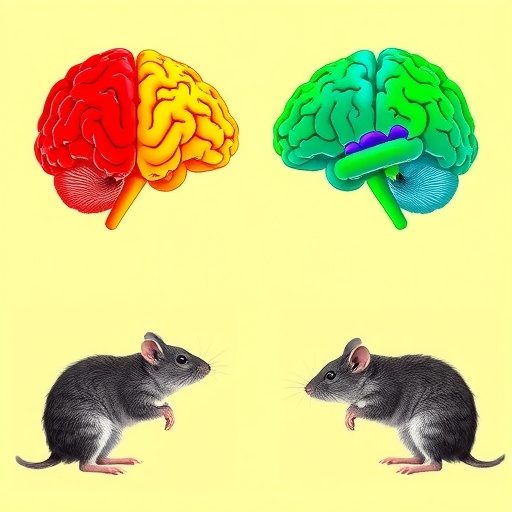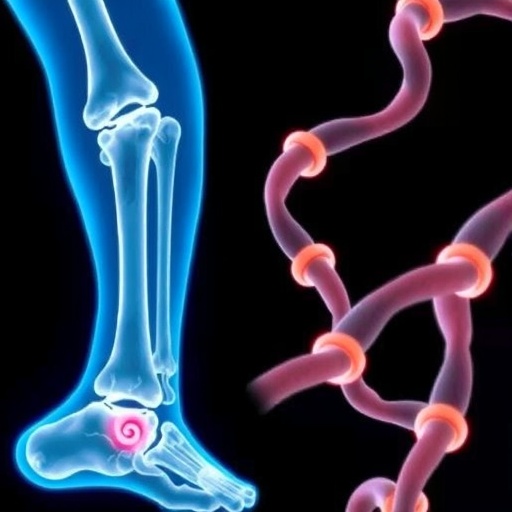In the intricate landscape of neuroanatomy, the quest to understand sex differences has garnered significant attention over the years. Recent research led by a team of scientists, including Pham, Guma, and Ellegood, offers a groundbreaking examination of these differences across species. Their study, titled “A cross-species analysis of neuroanatomical covariance sex differences in humans and mice,” delves into variations that might explain behavioral and physiological disparities observed between sexes. This exploration is not just relevant for academic discourse but for understanding the broader implications on health, behavior, and neurodevelopment.
The analysis unveils a series of compelling findings that underscore the complexity of gendered neuroscience. As the study compares neuroanatomical data between humans and mice, it emphasizes the importance of species-specific factors in interpreting sex differences in brain structure and function. The researchers utilized advanced imaging techniques and statistical models to map out how these disparities manifest; a process that is both methodologically intricate and enlightening. Understanding these variances can illuminate paths to better healthcare tailored to specific sex needs, potentially transforming treatment approaches in mental health and neurodevelopmental disorders.
Central to this research is the concept of neuroanatomical covariance. This principle posits that specific brain structures may exhibit variability in size or density based on sex, showcasing a biological underpinning to behaviors and cognitive functions. The study provides visual representations demonstrating these covariances, highlighting stark variances in regions traditionally associated with emotional regulation, cognitive processing, and even sensory perception. Moreover, these sex differences could serve as crucial indicators for understanding predispositions towards certain neurological conditions, further bridging the gap between biological research and clinical application.
The methodological rigor involved in this study is noteworthy. By employing large sample sizes and control for confounding variables, the research stands out in its reliability. Such a robust framework not only strengthens the validity of the findings but also sets a precedent for future investigations. The cross-species design, which carefully considers the genetic, environmental, and developmental nuances inherent in both humans and mice, provides a comprehensive perspective that is often lacking in singular-species studies. This approach opens the door for a deeper exploration of evolutionary perspectives on sex differences, potentially leading to a more unified understanding of neuroanatomy across species.
The implications of these findings extend beyond mere academic curiosity. In clinical settings, recognizing the ways in which male and female brains develop differently could significantly influence treatment methodologies for mental health issues. For example, treatments for disorders such as depression, which exhibit sex-biased prevalence rates, could be refined to address these neuroanatomical differences directly. Observations made in the study about specific regions associated with anxiety and mood regulation highlight the importance of personalized medicine.
In addition to potential treatment avenues, the research raises questions about the societal implications of understanding sex differences in brain anatomy. As society continues to grapple with issues of gender identity and roles, the findings from this study can serve to inform discussions on the biological underpinnings of behavior. This scientific insight could lead to a reduction in stigmas surrounding mental health, as it lays bare the physiological reasons behind differing behavioral patterns.
Another vital aspect of the research lies in its focus on neurodevelopmental stages. The investigation dives into how sex differences manifest not just in adult brain structures but also during critical developmental periods. This insight is pivotal for understanding disorders that begin in childhood, advocating for early intervention strategies that are sensitive to sex differences. Insights gained from these developmental trajectories could foster strategies for educational and therapeutic interventions that better serve both boys and girls.
The discourse around sex differences in neuroscience is expanding, but it is crucial to approach these topics with sensitivity and awareness of the overarching societal narratives. This study aims to equip scientists, clinicians, and policymakers with the data needed to foster more informed decisions regarding gender and brain health. This is particularly critical in an era where gender discussions are becoming increasingly nuanced, necessitating a scientific basis for understanding implicating factors that influence behavior and cognition.
Overall, the synergy between behavioral science and neuroanatomical studies promises rich avenues for discovery. The implications of such research stretch into various domains, from education systems to workplace policies, highlighting the importance of embracing neurodiversity as a continuum rather than a binary framework. This understanding can cultivate a more inclusive environment that respects and nurtures individual differences rooted in biological diversity.
As the understanding of sex differences in neuroanatomy evolves, it will undoubtedly influence future research trajectories. The foundation laid by Pham et al. establishes a benchmark for subsequent studies aimed at unraveling the complexities of brain structure and function through a gendered lens. The future of neuroscience may very well hinge on this increased awareness of biological distinctions and how they shape experiences and behaviors.
In conclusion, the comprehensive work of Pham, Guma, Ellegood, and their collaborators is a testament to the power of interdisciplinary research, illustrating how combining insights from genetics, neuroanatomy, and behavioral science can lead to transformative findings. It invites a new paradigm of thinking about sex differences while fostering a respect for individual variability, thereby paving the way for innovative approaches in both research and clinical practice.
This illuminating study not only enriches the scientific community but also promises to make a tangible difference in the lives of those affected by sex-based neurological disparities. As research continues in this vein, the critical overlap of biology and behavior will usher in the next generation of neuroscience, one that respects the intricate interplay of sex and brain health.
Subject of Research: Neuroanatomical covariance and sex differences in humans and mice.
Article Title: A cross-species analysis of neuroanatomical covariance sex differences in humans and mice.
Article References:
Pham, L., Guma, E., Ellegood, J. et al. A cross-species analysis of neuroanatomical covariance sex differences in humans and mice.
Biol Sex Differ 16, 47 (2025). https://doi.org/10.1186/s13293-025-00728-1
Image Credits: AI Generated
DOI:
Keywords: Neuroanatomy, sex differences, covariance, brain structure, humans, mice, neurodevelopment, mental health.
Tags: advanced imaging techniques in neurosciencebehavioral implications of sex differencescross-species brain structure comparisongendered neuroscience insightsimplications for mental health treatmentmethodological approaches in neuroanatomyneuroanatomical covariance in humans and miceneurodevelopmental disorders and sex differencessex differences in neuroanatomysex-specific brain structure researchspecies-specific factors in brain researchunderstanding physiological disparities by sex






